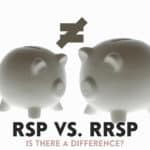RSP vs. RRSP: Is There a Difference?

Among Canadian investors, there’s a common misconception that the terms RSP and RRSP are one and the same. But while they are related, an RRSP is a type of RSP for example, they refer to different things. In this article, I’ll explain the difference between RSPs and RRSPs, and show you how you can use both to your advantage when it comes to creating an effective retirement strategy.
What Is an RSP?
A retirement savings plan, or RSP, refers to any investment that makes up a person’s retirement savings. RSPs can include a registered retirement savings plan (RRSP), employer pension plan (RPP), a TFSA account, even non-registered savings. So an RRSP is a type of RSP, but an RSP is not the same as an RRSP. Make sense?
RRSPs Explained
The term RRSP stands for Registered Retirement Savings Plan and refers to a specific type of government-sponsored account in which contributions are tax-deductible, and holdings are tax-sheltered until they are withdrawn. I’ll get into RRSPs in more detail below, but they are considered to be the most well-known form of retirement savings in Canada.
What Are My RSP Options?
With so many ways to save for retirement, an RRSP should never be the only solution. Far from it, in fact. Let’s take a closer look at a number of RSP options, including RRSPs, that are available to Canadians today.
RRSPs
Registered Retirement Savings Plans have been around since the 1950s. What distinguishes an RRSP from other plans is that the contributions are tax-deductible. In other words, each year, your taxable income is reduced by the amount you contribute, resulting in immediate tax savings. How much you save in tax will depend on your overall income and marginal tax rate.
In addition to tax deductibility, an RRSP acts as a tax shelter, meaning that the funds inside an RRSP grow tax-free until they are withdrawn, presumably after retirement. If you are married, you can contribute to an RRSP in your spouse’s name, to benefit from further tax savings. The funds in an RRSP can be invested in any number of ways, including GICs, mutual funds, stocks, and ETFs.
RPPs
A Registered Pension Plan (RPP) refers to either a defined benefit or defined contribution pension plan held with an employer and is another example of a type of RSP. With an RPP, the employee’s contributions are tax-deductible, but the employer’s portion is not. A defined benefit plan provides a lifetime guaranteed income, based on a predetermined formula. A defined contribution plan means that the contribution amounts are predetermined, but there is no income guarantee at retirement. It all depends on how the investments perform.
Because of the guaranteed retirement income, defined benefit plans are highly sought after, but they are also far more expensive for the employer, and as such are dwindling in number. These days, not many companies offer defined benefit plans, outside of the public service, and a handful of private corporations. Any RPP is a valuable component of a person’s retirement savings.
TFSAs
Because the funds in a Tax Free Savings Account (TFSA) can be included in a retirement savings strategy, it’s considered to be another form of RSP. Similar to an RRSP, the funds in a TFSA are tax-sheltered, however, contributions are not tax-deductible. One big advantage of including a TFSA in your retirement plan is that, unlike an RRSP, you won’t be taxed when the money is withdrawn after retirement. Like an RRSP, you can invest money in your TFSA any number of ways, from safety investments like GICs, to exchange traded funds (ETFs) and stocks.
A common debate is whether it’s better to save for retirement in an RRSP or a TFSA. In my opinion, you should use both plans. Of course, depending on your individual situation, you may want to prioritize one over the other.
Non-Registered Accounts
It’s not often discussed, but non-registered investments can also form part of your retirement strategy, making this another form of RSP. Conventional wisdom would suggest that you first maximize contributions to your RRSP and TFSA, but what happens when you run out of room? While the income generated by a non-registered account is taxable, there are ways to minimize the tax you pay, by favouring investments that pay dividends and capital gains, as opposed to straight interest income. Another benefit to a non-registered account is that it can be held jointly with your spouse, or another family member, whereas registered accounts cannot.
Final Thoughts on RSP vs. RRSP
Now that you know the difference between RSPs and RRSPs, you can decide which accounts to want to include in your overall retirement savings strategy. If the company you work for has an RPP plan, make sure you’re enrolled. If not, you’re missing out on what could be a major source of income at retirement. From there, start contributing to an RRSP and a TFSA account. If your budget is tight, it’s ok to start small. You can contribute as little as $25/month to each account type. Last, but not least, if you’re maximizing your contributions to registered accounts, consider opening a non-registered investment account to further boost your retirement savings.


Comments
Really? – Sorry (very CDN eh?), this is hair splitting definitions – the biggest issue is not acronyms but the fact that lot’s for folks are not using, or under utilizing, any of them
I agree on the importance of using RRSPs, but that’s not what this article was addressing. I’ve had multiple readers ask me this question as they’re new to RRSPs and the banks can confusingly use these terms interchangeably. While answering this question for them, you’ll see I linked to various articles to help them gain more knowledge on RRSPs.